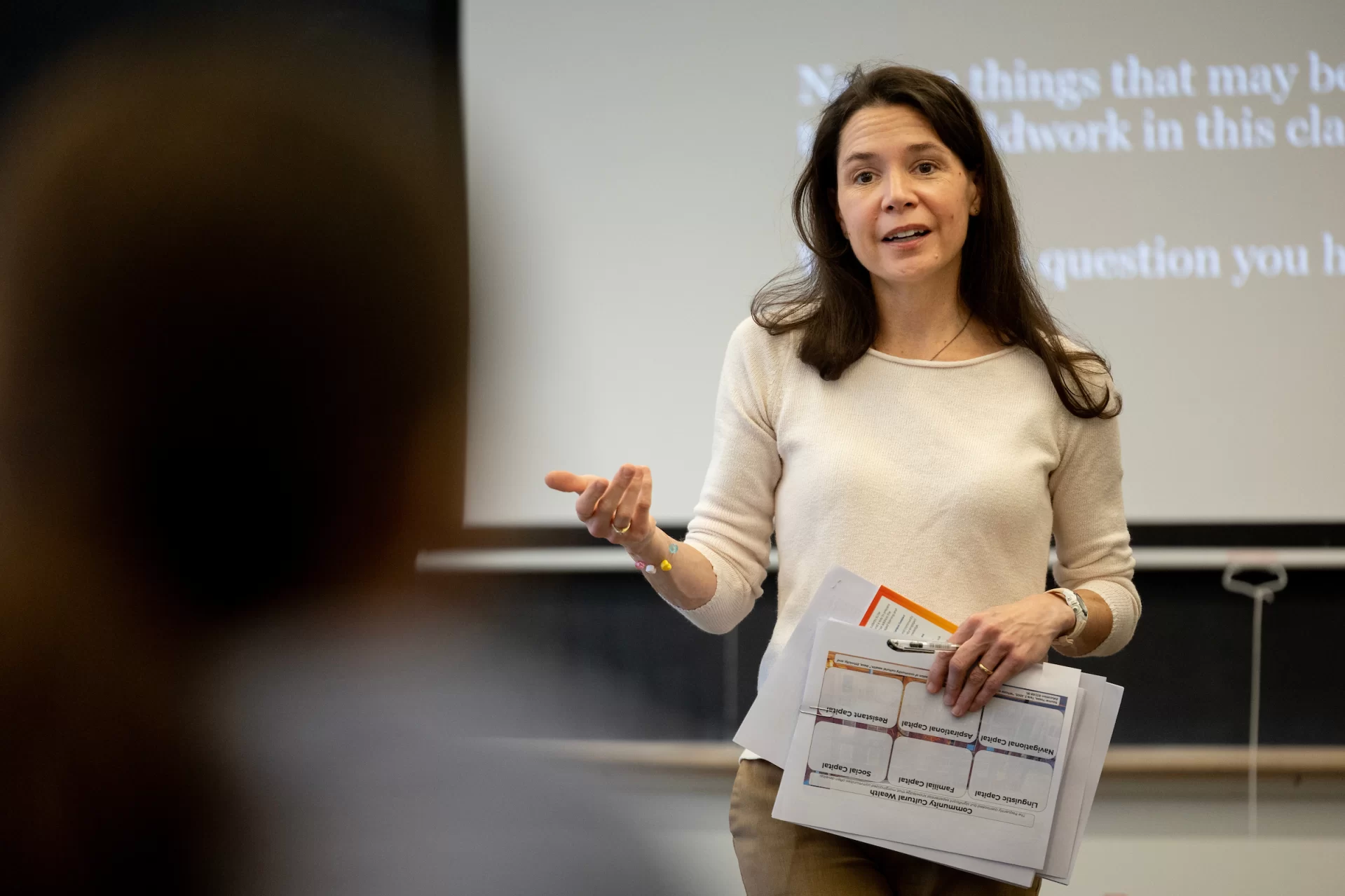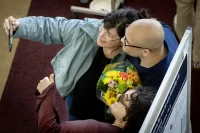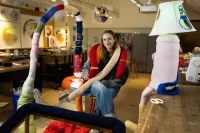'Green Horizons' participants and projects
![]()
Agnes Denes: Denes, who has had more than 300 exhibitions across four continents, approaches art from a multidisciplinary approach, transforming intellectual explorations into unique works of art. Her work analyzing the relationship of science and art made her an initiator of the environmental art movement. In Green Horizons, she shows Cibachrome images of major land transformation projects.
Chris Jordan: A Seattle-based photographer, Jordan’s Green Horizons participation is images from his “Intolerable Beauty” series — large-scale images of technological refuse, such as heaps of discarded cell phones and circuit boards.
David Maisel: Work by Maisel, a photographer based in the San Francisco Bay area, is represented in major collections including the Metropolitan Museum of Art and the Los Angeles County Museum of Art. His “Lake Project” comprises aerial images of Owens Lake, a shrinking lake whose exposed lakebed has become the highest U.S. source of particulate matter pollution. “Viewed from the air,” he writes, “vestiges of the lake appear as diverse as a river of blood, a microchip, a bisected vein, or a galaxy map.”
Alexis Rockman: Rockman is an artist, explorer and naturalist who examines the environmental plight of the earth as humanity continues on its current course of ecological devastation. His works explore how time, place, and scale are reflected through the history and potential future of science. Rockman is one of the most influential artists working in the realm of science and art today. His “Manifest Destiny,” an 8-by-24-foot panoramic landscape, represents downtown Brooklyn in the year 5000, after three millennia of global warming have submerged it underwater.
Karen Adrienne: Chair of the art department at University of Maine at Augusta, Adrienne has implemented a reduction of toxic materials in her practice and the university’s studios. She has also taken interest in sustaining her community by purchasing and renovating a vacant building in Gardiner to create The Art Dogs, a collaborative press and artist studio/living spaces. In Green Horizons, she shows a series of rust prints made from reclaimed industrial steel plates.
Michael Shaughnessy: Chair of the art department at the University of Southern Maine, Shaughnessy is a widely exhibited sculptor. His large-scale constructions of hay use a renewable, biodegradable resource. The construction of his works often includes labor donated by groups from the community in which a given work will reside. His geometric forms suggest both contemporary minimalist abstraction and Neolithic earthworks.
Beth O’Halloran: O’Halloran spent part of her childhood in Lewiston, Maine, and now lives in Dublin, Ireland. She has exhibited widely throughout Ireland, the U.K., New York and Japan. Her paintings address aspects of atmosphere, presence and absence. For Green Horizons, she will be using as reference material an archival photograph of the Androscoggin River as it passes the Libbey Mill, built, owned and operated by O’Halloran’s ancestors to create “Breaking Falls,” a highly symbolic comment on the destruction of landmarks for the creation of a public water supply in Lewiston.
Mark Silber: A Sumner resident, accomplished photographer and cultural anthropologist, Silber teaches and lectures on oral history and documentary photography and has achieved national recognition as an author and co-author of eight books. Committed to organic farming for nearly 30 years, Silber played an instrumental role in the resurgence of farmers markets throughout Maine. His Green Horizons installation, “Portrait of a Garden,” will consist of two counterrotating vitrines that portray a gardening year in photographs. This project is supported by a Maine Arts Commission Good Idea Grant.
Anne-Katrin Spiess: Spiess creates site-specific and performance-based projects in wide-open remote landscapes, where the severance from civilization creates a great distance from the “real” world. Her projects exist only for a few hours or days at a time, and before they are disassembled and the landscape returned to its original condition, she documents them through photography, video and text. For Green Horizons, Speiss will map her process of researching the most carbon-neutral method of traveling to Bates from New York City.
Virginia Valdes: Valdes, of Sumner, brings a project titled “Wasteland: From Landfill to Artfill.” “Being constructed with only the refuse of homo industrialis, the installation grapples with how a human habitat filled with non-recyclable and non-degradable material goods not only inexorably eliminates others and, ultimately, all life, but increases the artificial and cultural divide between humans and their biological environment,” she writes. This project is supported by a grant from the LEF Foundation.
Beehive Collective: Showing banners that make political and social commentary in Green Horizons, “the Bees are based in Eastern Maine, but are a very decentralized swarm spread throughout Canada, Mexico, the United States and Europe,” the group writes. “Our mission is to cross pollinate the grassroots, by building connections between activists that use words, and those that speak in pictures, to help create more accessible, powerful campaigns for the important issues of our time. ”
Carol Dilley, Assistant Professor of Dance, and William Matthews, Alice Swanson Esty Professor of Music: Collaborating with the Bates-Morse Mountain Conservation Area, Museum L-A and the Lewiston Mills Complex, Dilley and Mathews’ “Imprints” examines how humans and the environment act mutually upon each other, continually redefining each other in that interaction. The project will involve dance, music composed by Matthews and digital video. Made possible by a Green Horizons Faculty Project Support Grant, funded by the Synergy Fund.
David Scobey, Director of the Harward Center for Community Partnerships and Donald W. and Ann M. Harward Professor of Community Partnerships, and Christina Bechstein, sculptor: Using the woven textile as a metaphor for the city, “The Fabric Project” will involve weaving, mapping and story-telling with neighbors in Lewiston. “We will aim to capture and celebrate the stories of resiliency and survival of the people of Lewiston and will use both oral and visual workshop methods,” write Scobey and Bechstein. A Green Horizons Synergy Project.
PearsonWidrig DanceTheater and composer Robert Een in collaboration with festival Director Laura Faure and Bates Dance Festival: “Pond,” to be developed during an intensive residency at the Bates Dance Festival in July-August 2007, will use the medium of performance to manifest and celebrate the festival’s 25th anniversary. The piece is designed to take place on and around Lake Andrews, using water as its primary metaphor. A Green Horizons Synergy Project.
Kimberly N. Ruffin, Professor of English, artist Seitu Kenneth Jones, artist, park ranger Bruce Barnes, and Lots to Gardens, with director Kirsten Walter: Working with community groups associated with the Lewiston nonprofit Lots to Gardens, “Sighting and Sounding Sustainability” will explore culturally relevant crops and choose ones that will be planted in a garden by community members. The group will also create a “Shrine to the Collard Green” in and around the museum. A Green Horizons Synergy Project.
Jonathan Skinner, Assistant Professor of Environmental Studies and poet and visual artist Julie Patton: “Foot Prints” will be developed with a Bates course on “ecopoetics” in the context of the reconstructed wilds of urban landscapes. Working with the Stanton Bird Club and the Thorncrag Nature Sanctuary to explore postindustrial or otherwise abandoned areas, the project will explore the linkage of “wild” and “cultivated” to create works that shed startling light on linguistic, racial and economic border issues seldom otherwise developed in “environmental” contexts.
Andrea Bisceglia and Molly Ladd: These students will produce “Urban Fruit Orchard,” a project designed to raise awareness of the importance of trees on campus and in the community. Specifically, it will entail establishing an urban fruit orchard in the former Franklin Pasture in collaboration with the local non-profit Lots to Gardens. A Green Horizons Student Initiative.
Jacob Bluestone: A Bates student and photographer, Bluestone interns at The Bakery Photographic Collective in Westbrook. He has collaborated on photography projects with youth groups in Bolivia and Maine. His “Manufactured Space” will comprise a photographic exploration of the consumption of space in America, inspired by his recent exploration of the American West. A Green Horizons Student Initiative.
Taegan McMahon: In “Sustainable Wardrobe,” this Bates student — already a professional seamstress — will craft a full wardrobe from locally produced fibers and recycled natural fabrics. Drawing upon her training in biology and her background as a naturalist, she will accomplish all dyeing through use of locally grown or indigenous flora. A Green Horizons Student Initiative.


